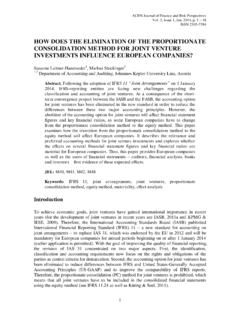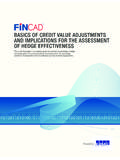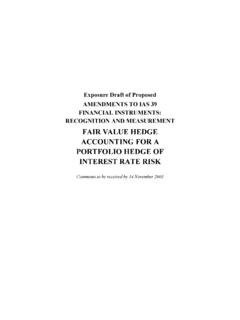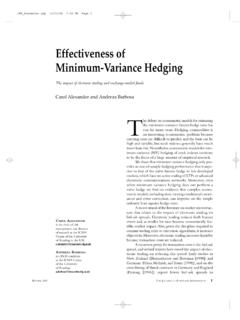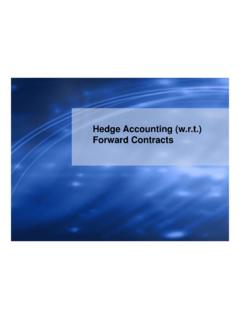Transcription of IFRS 9: THE NEW RULES FOR HEDGE ACCOUNTING …
1 ACRN Journal of Finance and Risk Perspectives Vol. 3, Issue 3, November 2014, p. 53 66. ISSN 2305-7394. IFRS 9: THE NEW RULES FOR HEDGE ACCOUNTING . FROM THE RISK management 'S PERSPECTIVE. Thomas Bernhardt1, Daniel Erlinger1, Lukas Unterrainer1. 1. University of Applied Sciences, Upper Austria, Master Degree Course Controlling, ACCOUNTING and Financial management . Abstract: HEDGE ACCOUNTING RULES of IFRS ensure that earnings and expenses regarding hedging relationships are accounted simultaneously. These RULES should avoid an economically not justifiable increase in earnings volatility through hedging relationship.
2 The crucial issue in HEDGE ACCOUNTING is the separation between financial instruments that are used for speculation purposes and financial instruments that are used by an entity to HEDGE a risk exposure. HEDGE ACCOUNTING RULES of IAS 39 are often criticized as being too complex and not aligned with entities' risk management strategies. Therefore, entities are faced by the trade-off between an optimal hedging strategy, which probably does not qualify for HEDGE ACCOUNTING , and a sub-optimal hedging strategy, which qualifies for HEDGE ACCOUNTING and decrease earnings volatility, but does not fully meet the objective of entity's risk management .
3 As a consequence of criticism the IASB published in November 2013 the new RULES for HEDGE ACCOUNTING under IFRS 9. The new RULES should eliminate weaknesses of IAS 39 by making HEDGE ACCOUNTING RULES less complex. Furthermore IFRS 9 should align HEDGE ACCOUNTING RULES with companies' risk management strategies. Keywords: IFRS 9, IAS 39, HEDGE ACCOUNTING , HEDGE effectiveness, risk management , derivative financial instruments Introduction Companies try to HEDGE their risk exposures, often by using derivative financial instruments.
4 Hedging relationships usually consists of the hedged item and the hedging instrument, which should compensate the volatility of gains and losses of the hedged item. General ACCOUNTING RULES often cause that the hedged item and the hedging instrument are considered differently and therefore gains and losses resulting from the two instruments are not accounted simultaneously in profit and loss-account. As a result hedging relationships could lead to an increase in earnings volatility. HEDGE ACCOUNTING means a set of RULES to prevent companies, which use hedging instruments, from an economically not justifiable increase in earnings volatility.
5 In the International Financial Reporting Standards (IFRS) RULES for HEDGE ACCOUNTING are currently defined in IAS 39 Financial Instruments: Recognition and Measurement. However, these RULES are often criticised as being too complex and not aligned with entities' risk management strategies. Especially the second point of criticism often represents a trade-off for companies. Either risk management implement a hedging strategy, which is economically sub-optimal, but allows the application of HEDGE ACCOUNTING RULES . Alternatively, the optimal hedging strategy leads to an increase in earnings volatility, because the hedging relationship does not 53.
6 IFRS 9: THE NEW RULES FOR HEDGE ACCOUNTING FROM THE RISK management 'S. PERSPECTIVE. qualify for HEDGE ACCOUNTING . Therefore hedging strategies of business entities are usually strongly influenced by ACCOUNTING standards (cf. Panaretou, et. al., 2013, 116). The International ACCOUNTING Standards Board (IASB) has finalized the adoption of RULES for HEDGE ACCOUNTING under IFRS as part of IFRS 9 Financial Instruments. The standard will replace the RULES of IAS 39 in multiple phases, whereby RULES for HEDGE ACCOUNTING (phase 3).
7 Have been published in November 2013. This article presents the main points of criticism of HEDGE ACCOUNTING RULES under IAS 39. and the most important RULES of HEDGE ACCOUNTING under IFRS 9. Furthermore it will take a look on the new RULES of IFRS 9 and the related changes from the risk management 's perspective. Points of criticism regarding HEDGE ACCOUNTING RULES under IAS 39. Hedging relationships usually consists of two separate transactions, the hedged item and the hedging instrument. According to the general ACCOUNTING RULES of IAS 39, the two transactions have to be measured on an item-by-item-basis.
8 As the hedging instrument is usually a derivative financial instrument, it has to be measured at fair value through profit or loss (FVTPL). In contrast the hedged item is usually classified in a different category, with different RULES for measurement. These differences in classification lead to an asynchronous periodic measurement of income and loss concerning the financial instruments, which are part of the hedging relationship. These ACCOUNTING mismatches lead to an increase in earnings volatility which is economically not justified (cf.)
9 Glaum, Kl cker, 2010, 6). Doupnik and Perera (2012) pointed out, that as a result hedging relationships might not be shown accurately in companies' financial statements. IAS 39 provides specific HEDGE ACCOUNTING RULES to avoid such ACCOUNTING mismatches and economical unjustifiable increases in earnings volatility. These RULES are exceptions of the general RULES and can be voluntarily applied. The RULES of HEDGE ACCOUNTING should ensure that income or loss of the hedging instrument and the hedged item are synchronized between periods (cf.
10 Kablan, 2014, 102). IASB (2012) defines HEDGE ACCOUNTING as a mechanism to reflect the risk management activities in companies' financial statements. Conditions for hedging relationships to qualify for HEDGE ACCOUNTING IAS defines the conditions which have to be cumulatively fulfilled that a hedging relationship qualifies for HEDGE ACCOUNTING . Firstly, there has to be a formal designation and documentation at the inception of the hedging relationship. Secondly, the hedging relationship has to be highly effective and has to be assessed during the duration of the HEDGE .

